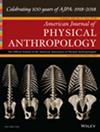Weight support distribution during quadrupedal walking in Ateles and Cebus.
IF 2.6
2区 地球科学
Q1 ANTHROPOLOGY
American journal of physical anthropology
Pub Date : 2011-04-01
Epub Date: 2011-01-06
DOI:10.1002/ajpa.21460
引用次数: 76
Abstract
While it is well known that primate quadrupeds are distinctive in supporting more body weight on their hind limbs than their forelimbs, it has been unclear how this support asymmetry comes about. The simple explanation of a difference in body center of mass (COM) position is not supported by empirical data, leaving two less intuitive proposals. The first involves the position of the hands and feet relative to the COM, and has recently received support by Raichlen et al. (Am J Phys Anthropol 138 (2009) 395-402) who document that chimpanzees walk with a relatively protracted hind limb, bringing their feet closer to the COM for greater hind limb weight support. The second posits the use of hip retractor muscles to actively shift weight off the fore- limbs and onto the hind limbs, and has received recent support by Larson and Stern (Am J Phys Anthropol 138 (2009) 343-355), who report higher levels of hip extensor activity in primates that bear more weight on their hind limbs. Since the study by Raichlen et al. (Am J Phys Anthropol 138 (2009) 395-402) is based on a limited empirical dataset, we have undertaken a replicate study to document average limb posture and weight support distribution in two additional primate species: Ateles and Cebus. Using the equations presented by Raichlen et al. (Am J Phys Anthropol 138 (2009) 395-402), predicted forelimb weight support based on limb posture was com- pared to observed values based on vertical impulses. In contrast to their findings, the limb posture model dra- matically overestimated actual forelimb weight support in the monkeys, calling into question the general applic- ability of this model. Am J Phys Anthropol 144:633-642, 2011. V C 2011 Wiley-Liss, Inc.四足步行时的重量支撑分布。
本文章由计算机程序翻译,如有差异,请以英文原文为准。
求助全文
约1分钟内获得全文
求助全文
来源期刊
CiteScore
4.80
自引率
0.00%
发文量
3
审稿时长
3-8 weeks
期刊介绍:
The American Journal of Physical Anthropology (AJPA) is the official journal of the American Association of Physical Anthropologists. The Journal is published monthly in three quarterly volumes. In addition, two supplements appear on an annual basis, the Yearbook of Physical Anthropology, which publishes major review articles, and the Annual Meeting Issue, containing the Scientific Program of the Annual Meeting of the American Association of Physical Anthropologists and abstracts of posters and podium presentations. The Yearbook of Physical Anthropology has its own editor, appointed by the Association, and is handled independently of the AJPA. As measured by impact factor, the AJPA is among the top journals listed in the anthropology category by the Social Science Citation Index. The reputation of the AJPA as the leading publication in physical anthropology is built on its century-long record of publishing high quality scientific articles in a wide range of topics.

 求助内容:
求助内容: 应助结果提醒方式:
应助结果提醒方式:


